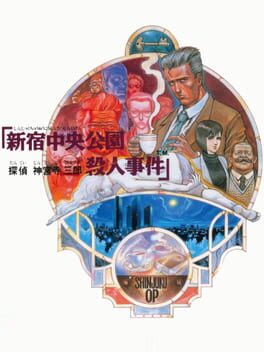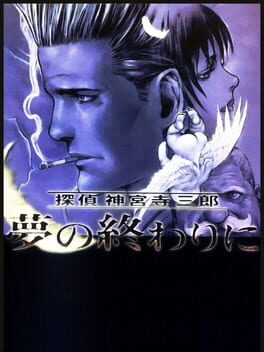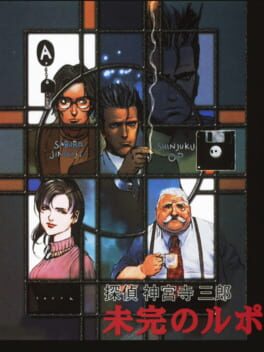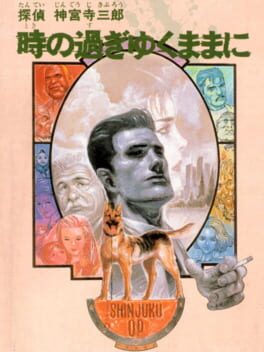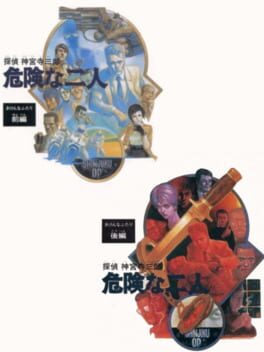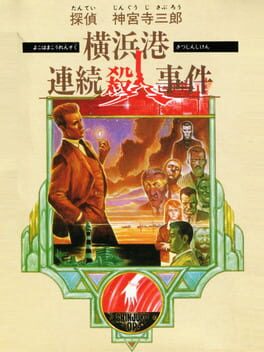

Tantei Jinguuji Saburou: Shinjuku Chuuou Kouen Satsujin Jiken
The first installment in the long-running Tantei Jinguuji Saburo (Jake Hunter) series about the mystery behind the death of a young woman whose corpse was discovered in Shinjuku Central Park. Tantei Jinguuji Saburo: Shinjuku Chuo Koen Satsujin Jiken ("Detective Saburo Jinguuji: Shinjuku Central Park Murder Mystery") is the first in a long-running series of crime-themed adventure games from Data East regarding the detective Saburo Jinguuji, or Jake Hunter as he is known in the West. As with all the games that follow, the goal of the game is to discover the perpetrator behind a murder by talking to witnesses and suspects, gathering clues and deducing facts about the case. The player can use a menu of options with which to control Detective Jinguuji's investigation, such as "Talk" and "Look" commands to get a better sense of the world of the game.
Also in series
Reviews View More
– Yōzaburō Kanari, 'Yukikage Village Murder Case' (File 23), Kindaichi shōnen no jikenbo - Case Series, 1999.
The Tantei Jingūji Saburō series belonged to the first generation of Japanese detective games, whose early explorations allowed them to branch out in very varied directions; while Portopia Renzoku Satsujin Jiken (1983) and Yamamura Misa Suspense (1987) offered fairly traditional, honkaku mysteries, more atypical titles such as Sanma no Meitantei (1987) were deliberately more humorous and light-hearted. Tantei Jingūji Saburō positioned itself as a representative of hard-boiled detective fiction, which is not necessarily an obvious idea. From the 1920s to the 1950s in the United States, the genre enjoyed a very apparent surge, inspired by the social changes in the country, by sacrificing the traditional codes of detective fiction – namely the emphasis on solving the crime – for a darker portrayal of society.
Hard-boiled crime fiction in Japan
Japanese crime fiction, which has its own codes compared to the West, did not embrace this fundamental change. The hard-boiled remained a very modest part of the genre and was reinterpreted rather late in Japanese social crime fiction (shakai), especially in women's fiction [1]. As such, Tantei Jingūji Saburō is something of a notable exception in Japanese production and serves as a convenient fulcrum for understanding the evolution of the genre over the decades. The first title, Shinjuku Chūō Kōen Satsujin Jiken, highlights the characteristic features of the franchise. At the request of Inspector Sanzō Kumano, the player must solve the murder of Momoko Takada, a hostess at Shinjuku's Bar East.
In grand Japanese tradition, the player is presented with an impossible situation, as the victim's body was found in the middle of Shinjuku chūō kōen, a park nestled among Tokyo's tall buildings and offices. The problem is that it was raining on the night of the murder and no footprints were found at the crime scene. Given this difficult premise, the player is given an extraordinary degree of freedom. While the controls are fairly traditional, with the eternal 'Ask' and 'Examine', Shinjuku Chūō Kōen Satsujin Jiken also allows the player to call out to passers-by or take photographs. More amusingly, it is possible to accuse suspects or threaten various characters, with sometimes unexpected consequences. Amidst all the possibilities, critical actions are highlighted by rather ominous musical jingles, the game's only soundtrack.
Freedom and limits in 1980s Japanese detective games
The investigation must be carried out efficiently and quickly, as the game has an internal timer that runs out with each action taken, with the player having only a fortnight to complete the investigation. More than its predecessors, Shinjuku Chūō Kōen Satsujin Jiken has a formidable difficulty. While the initial inquiries are fairly straightforward and provide a reasonably good understanding of the relationships that bind the victim's acquaintances together, the progression of the title is tied to exploring Shinjuku Central Park. The title uses an overhead view, and identifying places to investigate is jarring, as they are not explicitly labelled and the player has to check every tile by switching to the subjective view: stopping by the local police station and examining the crime scene can be missed, preventing the discovery of clues crucial to solving the case.
Despite the capricious progression of the investigation, which requires the player to go through very specific triggers, Shinjuku Chūō Kōen Satsujin Jiken still charms with its very urban flair, which contrasts with the more picturesque cases of Misa Yamamura. The game offers a rather exotic cross-section of Shinjuku, halfway between the elegance of the offices, the nocturnal life and the end of the yakuza. The motive for the crime serves to underline the harshness of Japanese society, but the solution to the mystery is unsatisfactory. The concept of a crime scene with no footprints is a common one in crime fiction, with two possible subtypes: either there are no footprints at all, or only the victim's footprints are found.
The game falls into the first category. Meitantei Konan (1994) proposed this premise several times [2] and managed to get away with some very creative devices, but Shinjuku Chūō Kōen Satsujin Jiken fails to convince due to the improbability of the method used and its overly convenient nature. Nevertheless, the title remains an interesting and innovative take on the early investigation genre, offering much more room for manoeuvre than its contemporaries – even if it is ultimately under-exploited: the first part of the title leaves plenty of opportunity to wander between the suspects, but the second half opts for a very rigid structure that does not welcome the player taking liberties.
__________
[1] A chronological study shows that the 1990s saw a major restructuring in the field of Japanese detective fiction. In addition to the development of shin honkaku, women writers adopted characteristics of Anglo-Saxon hard-boiled fiction to express a different vision of society. In particular, Murano Miro, Natsuo Kirino's main protagonist, becomes a detective and gradually comes to understand the constraints of society. The novels are written in the first person and offer a completely female perspective. In Tenshi ni misuterareta yoru (1994), Miro fully exercises her independence, but is also confronted with a number of obstacles, especially as she has left the Japanese middle class. Moreover, the sexual relationships she enjoys do not serve to turn her into a woman-object: 'Kirino has created a female detective who, by virtue of her age and widowhood, escapes the normal pressure on young women to [pursue] marriage. Miro is able to have a relationship with anyone that she chooses and she also can control the outcome of her relationships. The likability of the men Miro selects is not at issue here, but rather her decision to enter and end the relationship.' (Amanda C. Seaman, Bodies of Evidence: Women, Society, and Detective Fiction in 1990s Japan, University of Hawai'i Press, Honolulu, 2004, pp. 92-93).
[2] 'Shiroi Sunahama Satsujin Jiken' (1997) uses a beach setting, while 'Kijutsu Aikōka Satsujin Jiken' (1998) features a snowy forest. In both cases, the environment is crucial in staging the murder.
